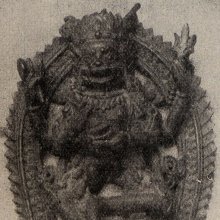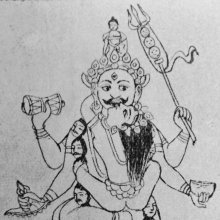Kauveri, Kauverī: 3 definitions
Introduction:
Kauveri means something in Buddhism, Pali, Hinduism, Sanskrit. If you want to know the exact meaning, history, etymology or English translation of this term then check out the descriptions on this page. Add your comment or reference to a book if you want to contribute to this summary article.
Images (photo gallery)
In Hinduism
Jyotisha (astronomy and astrology)
Source: Wisdom Library: Brihat Samhita by VarahamihiraKauverī (कौवेरी) refers to the “northern region”, according to the Bṛhatsaṃhitā (chapter 12), an encyclopedic Sanskrit work written by Varāhamihira mainly focusing on the science of ancient Indian astronomy astronomy (Jyotiṣa).—Accordingly, “I shall now expound about the movements of the Seven Ṛṣis (Saptarṣi), through whom the northern region [i.e., kauverī—ca dig yaiḥ kauverī] shines as though bedecked with a pearl necklace, like a maiden with a smiling countenance wearing a garland of white lotuses. Or by the direction of her lord—the Pole-Star (Seven Ṛṣis), the northern maiden (quarter) appears to dance round as the Seven Ṛṣis move in their course. I begin to treat of these stars adopting the views of Vṛddha Garga”.

Jyotisha (ज्योतिष, jyotiṣa or jyotish) refers to ‘astronomy’ or “Vedic astrology” and represents the fifth of the six Vedangas (additional sciences to be studied along with the Vedas). Jyotisha concerns itself with the study and prediction of the movements of celestial bodies, in order to calculate the auspicious time for rituals and ceremonies.
In Buddhism
Tibetan Buddhism (Vajrayana or tantric Buddhism)
Source: archive.org: The Indian Buddhist IconographyKauverī (कौवेरी) is one of the twenty-four Goddesses surrounding Buddhakapāla in the buddhakapālamaṇḍala, according to the 5th-century Sādhanamālā (a collection of sādhana texts that contain detailed instructions for rituals).—Buddhakapāla refers to one of the various emanations of Akṣobhya and the sādhana says that when Heruka is embraced by Citrasenā he gets the name of Buddhakapāla.—Kauverī stands in the south of the middle circle. She has a blue colour two arms, one face, ornaments of bones, brown hair rising upwards but no garlands of heads. She carries the kapāla in the left and the kartri in the right, and dances in the ardhaparyaṅka attitude.

Tibetan Buddhism includes schools such as Nyingma, Kadampa, Kagyu and Gelug. Their primary canon of literature is divided in two broad categories: The Kangyur, which consists of Buddha’s words, and the Tengyur, which includes commentaries from various sources. Esotericism and tantra techniques (vajrayāna) are collected indepently.
Languages of India and abroad
Kannada-English dictionary
Source: Alar: Kannada-English corpusKauvēri (ಕೌವೇರಿ):—[noun] the direction to the right of a person facing the sunset; the northern direction.
Kannada is a Dravidian language (as opposed to the Indo-European language family) mainly spoken in the southwestern region of India.
See also (Relevant definitions)
Starts with: Kauverikeya.
Full-text: Kauvera, Kaubera, Matri, Buddhakapala.
Relevant text
Search found 3 books and stories containing Kauveri, Kauverī, Kauvēri; (plurals include: Kauveris, Kauverīs, Kauvēris). You can also click to the full overview containing English textual excerpts. Below are direct links for the most relevant articles:
The Indian Buddhist Iconography (by Benoytosh Bhattachacharyya)
Padarthadharmasamgraha and Nyayakandali (by Ganganatha Jha)
Text 43: On Space (Diś) < [Chapter 5 - Of the Mahābhūtas (Ultimate Material Substances)]
The Devi Bhagavata Purana (by Swami Vijñanananda)

